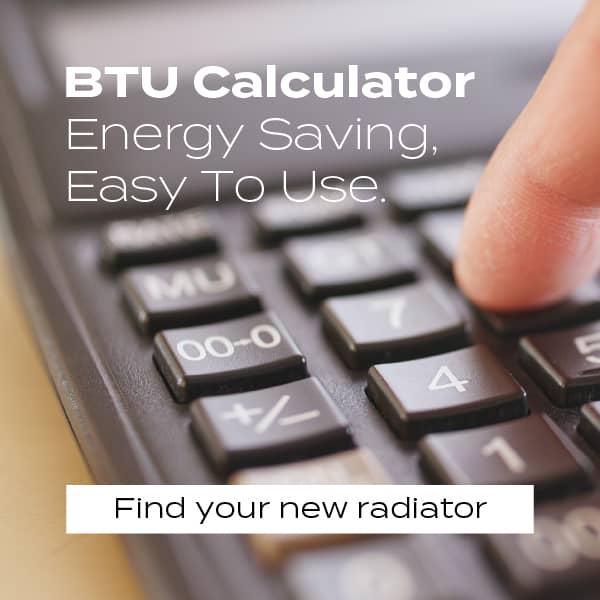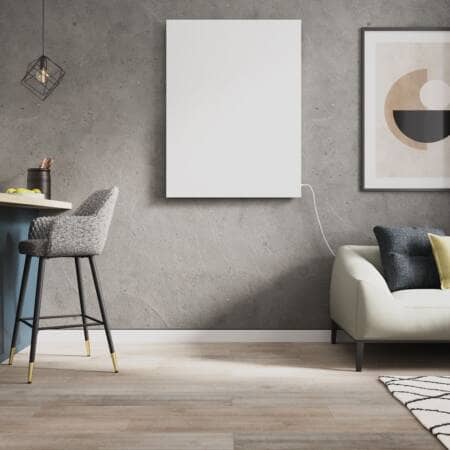Contents
ToggleExploring British Thermal Units
If you’ve been browsing our collection of radiators and heated towel rails, there is no doubt that you’ve come across the letters BTU.
But what does BTU stand for and what does it mean?
Well…
The BTU rate of a radiator is a quick and easy way of letting you know how much heat a radiator will emit, and is basically there to help you decide if a radiator is the correct size for your room or not.
It’s important to know just how much heat each room of your home needs in order for your system to work efficiently and for you to have a space that is neither too hot or too cold.
Design, style and finish are all very important factors when it comes to purchasing a radiator, but the most important part of making the right decision is the BTU output of the radiator that you need.
Carry on reading to learn all about BTUs.
So what is a BTU?
BTU stands for British Thermal Unit.
A BTU is the measurement used to represent the amount of energy it takes to heat one pound (1lb) of water (about a pint) by one degree Farenheit.
This measurement is more commonplace in the UK, but is also used throughout the world and is most commonly associated with energy, power, air-conditioning and steam generation.
BTU is the standard heat measurement when it comes to choosing radiators, and you’ll see it on the product specifications listed on every radiator and towel rail product page. (Though not on electric radiator listings).
Radiators and BTU
If you are looking to buy a new radiator, taking the time to calculate the correct number of BTUs you’ll need is integral to you making the correct purchase.
Too little BTU output and your room will not reach the required temperature and you’ll suffer from your space being cold and uninviting (and nobody wants that).
Too many BTUs and you could find yourself paying over the odds for heat that you don’t need and being far too warm.
It is important that you select a radiator or heated towel rail that has the adequate heat output for the space it’s been selected to live in.
You wouldn’t put a huge triple column radiator in a pokey little cloakroom, just as much as you wouldn’t put a small, single-panelled convector radiator in a huge open-plan sitting room.
It’s common sense really.
Calculating BTU
Don’t worry, you don’t have to be a mathematical genius to work out the BTU output your radiator needs have – you just need to be handy with a tape measure, count some windows and know what is on the other side of a few walls.
We’ve also got a great guide to calculating BTUs that might help too!
It will show you what you need to do work out your BTU needs in a little more detail and discuss how to use our BTU Calculator.
Our calculator is totally free to use and will make working out the required BTU amount easier than ever before.
You just need to know the area of the room you want to heat and a couple of other details too – like how many windows there are, whether they are single or double glazed and how many radiators there are in the room.
Our app explains in greater detail what it is that you need to enter, and it’s free!
Once you have the required details, you are armed and ready to make the right purchase; one that is better informed and more appropriate to the needs of your home heating.
How to choose the right radiator
- Measure your room – Know the dimensions of the room you want to heat. Work out the square metre area of the room in order to be accurate with the amount of heat you will need.
- Count the windows in that space – It is important to factor in the number of windows there are in the space. Draughts will contribute to the final BTU number.
- Count the radiators you’ll need – Do you need one, two, three or maybe even more radiators to make the most of your central heating.
- Know what is above and below the room – Knowing what is above and below the room will make a big difference to the final BTU number. Solid floors retain heat very differently to a floor with a cellar or a cavity.
- Know what is on the other side of each wall in the room – What is on the other side of the wall, and what the wall is made of, will play a big part in the size and output of the radiator you choose.
- Use our BTU Calculator – Take all of the information you have collected and make sure you have it to hand when you use our BTU Calculator.
Follow the checklist above and you will soon be enjoying the warmth and luxury of efficient, practical and beautiful new radiators that we specialise in here at BestHeating.
Let’s calculate those BTUs!
We’re sure you’ll find exactly what you’re after.
Stay Safe and Happy Heating.
Frequently Asked Questions
Several factors will determine if cheap designer radiators deliver an adequate BTU output, such as the size of the space they’ll be installed in, as well as the actual radiator size.
Furthermore, what you define as a cheap designer radiator will be influenced by a number of reasons, like what your radiator budget is, and how much you prioritise the look of your designer radiator in relation to performance quality and durability.
Our BTU Calculator can be used to show whether your chosen cheap designer radiator provides a high enough BTU output to adequately heat the room it will be fitted in. And for more information on the subject, you can take a look at our dedicated blog – Cheap Designer Radiators: Too Good To Be True?
British Thermal Units (BTUs) are specifically a unit of energy. Contrastingly, Watts (W) represent a measurement of the rate that energy is transferred.
When a conversion occurs from BTUs to Watts, it is actually essentially a conversion from BTUs per hour (BTU/h) into the equivalent amount of Watts.
One Watt equates to 3.41 BTUs per hour, so you divide the total number by 3.41 to convert from BTUs to Watts.
You can use our BTU Calculator to find the ideal heat output you may need to heat your chosen space.
However, when calculating wattage outputs, it is important to take into account the heat lost through transfer from the heating element, to the heating solution, and then from the heating solution to the metal of the radiator itself.
And while our BTU Calculator will give you a conversion based on some clever mathematics, if you are unsure of what this heat loss calculation may be, and want to be as accurate as possible, it may be advisable to consult a plumber or electrician for advice before purchase.
A single Watt (W) is equivalent to 3.41 British Thermal Units (BTUs) per hour (h).
As such, to convert BTUs per hour into Watts, you have to divide by 3.41.
In order to convert Watts into BTUs per hour, you should multiply by 3.41.
The BTU requirement per radiator will be determined by the amount of radiators featured in a specific room.
So, use a BTU Calculator to work out the total BTU requirement of the space, and divide this total by the number of radiators you are planning to install.
The result will be the average BTU level needed per radiator.

John trained in journalism before finding his way to the BestHeating Advice Centre team. He uses his journalism skills to meticulously research heating topics and bring you the latest news and views on all things home heating related. He’ll also beat you at any sport that involves a cue!






5 Responses
John,
Is the physical size of the radiator (total surface area of the panels) directly related to heat output, or is there more to it than that?
Using your BTU calculator my living room needs 4381 BTUs and have ordered from you a 600 X 800 double panel convector radiator (SKU 962208) which is rated at 4728 BTUs but the physical size, even with twin panels, seems quite small, after drawing its location out on the wall.
Hi Chris,
In regards to heat output the physical size of the radiator is not an important factor compared with output.
If you have correctly calculated the BTU output that you need for that room – taking into account the windows you have, the wall types, etc – then that particular model will do the job.
It’s always best to go a little higher on output anyway in my opinion, because you can always turn the heating down, but you can’t make something warmer than it’s top temperature.
Hi, just looking into getting a radiator for my front room which measures 12ftx11ftx8ft. Your BTU calculator calculates to 4676BTU. A couple of questions:
1. Is this calculation at delta 60 or delta 50 – does it make any difference?
2. Would having 2 small radiators be better/same/worse than having just one big one?
3. If I had 2 small radiators would that affect the boiler efficiency in that would it have to work harder, and would that then affect the rest of the heating system?
Would like to have 2 small ones on either side of a bay window to leave space in the middle for a seat, but don’t want to negatively affect the boiler or the rest of the heating system by doing so.
Thanks for your help
Hi Bal, sorry for the late reply on this.
I’ll try and answer your questions as best that I can…
1 – Is this calculation at delta 60 or delta 50 – does it make any difference?
The output does matter, as newer heating systems cannot reach the Delta 60 temperature. Delta 50 (which I believe our calculator to operate at) has an inlet temperature of 75 degrees Celsius, return of 65 and room temp at 20. Delta 60 gives you a higher output, but you would be receiving less heat from your radiators, which could lead to them not adequately heating your room.
2 – Would having 2 small radiators be better/same/worse than having just one big one?
The more radiators you have the harder the pump in your boiler would have to work, this is not a problem if the boiler has been sized correctly. Having two small radiators instead of one big one is more costly though, so keep that in mind..
3 – If I had 2 small radiators would that affect the boiler efficiency in that would it have to work harder, and would that then affect the rest of the heating system?
The only thing that has to work harder is the pump, as it has to pump a bit more because of the extra pressure drop.
I hope this helps.
Hello. I’m looking at the Milano Compact – Type 22 Double Panel Radiator – 600mm x 800mm with a BTU of 6,415. However, a different website is showing a Stelrad 600 x 800mm Type 22 Double Panel Radiator with a BTU of 4769. That’s quite a difference. Is there are any particular reason why the Milano has a higher BTU?